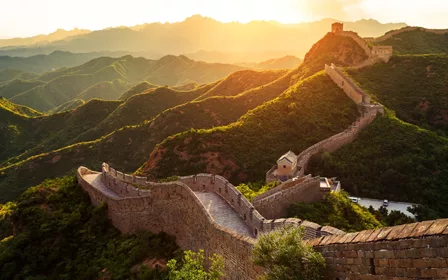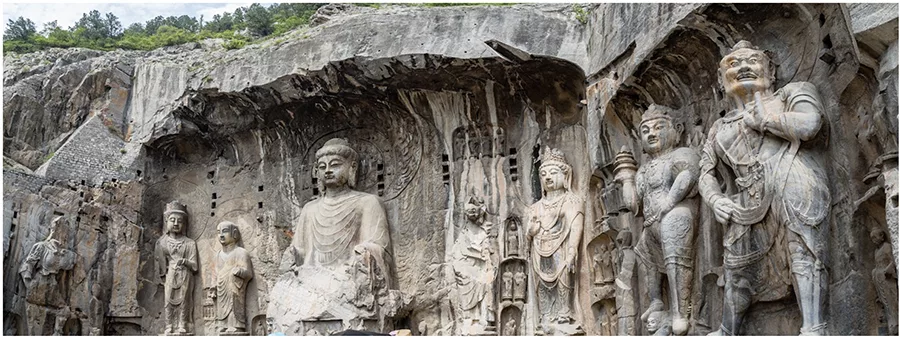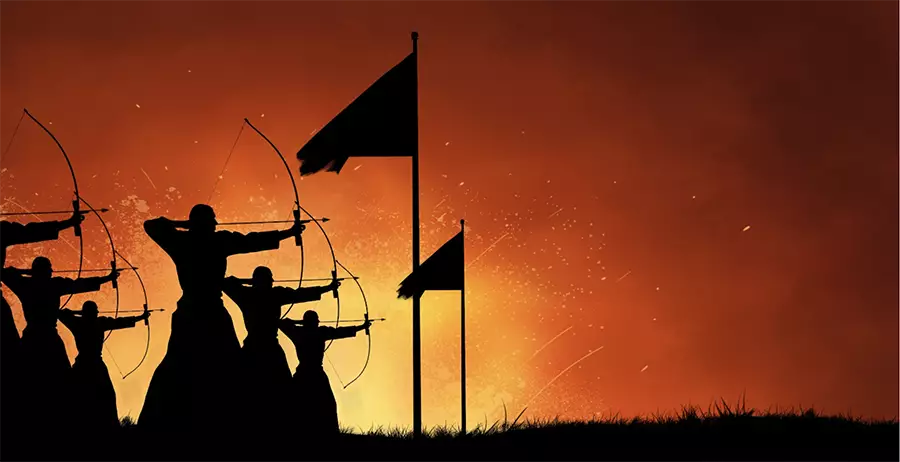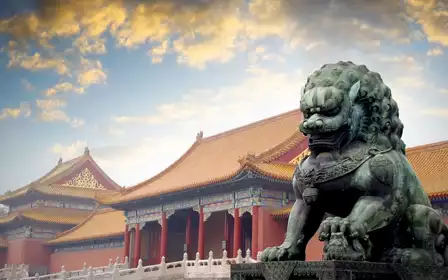Beyond Mulan - Using Literature to Learn about Ancient China
Introduction | Background Knowledge | Activities | Extensions | Standards

Introduction
Only one civilization can claim to be the longest-lasting empire in global history. This ancient civilization is also known for fireworks, silk, terracotta warriors, and the Great Wall. The Chinese civilization was ruled by emperors for over 2000 years and contributed many things to the modern world.

Click the image above to view a video that shows more about Ancient China.
Background Knowledge
While China's earliest inhabitants can be traced to Yuanmou Man, a subspecies of Homo erectus, who inhabited China about 1.7 million years ago, the "Cradle of Civilization" in the Yellow River Valley saw the rise of villages about 5000 BCE. From these communities, centralized forms of government began to develop, and the Xia Dynasty was established. In 1996, the Chinese government released information about the Xia Dynasty and dated it from 2070 and 1600 BCE. The Xia Dynasty established a familial line of succession as power remained in the same family until the dynasty was overthrown around 1600 BCE.
The Shang Dynasty (1600-1046 BCE) brought a reorganization to the Chinese ruling class. After the opulence and extravagance of the Xia Dynasty, the first ruler of the Shang Dynasty, Tang, lowered taxes in the country and ended many of the construction projects that started during the Xia Dynasty. The first written history of China was recorded during the Shang Dynasty as writing was developed. Religion was organized, architecture flourished, and the ancient Chinese began work with bronze during this era.
In 1046 BCE, King Wu, of the province of Zhou, rebelled against the king of Sheng when Wu's brother was brutally killed. This rebellion marked the beginning of the Zhou Dynasty, which spanned from 1046-256 BCE. Wu immediately sought to restore the ruler's connection to Shangti, the god of law, order, and justice. He championed the Mandate of Heaven. The Mandate of Heaven legitimized the ruler as having authority directly from Heaven. It also stated that there would be only one legitimate ruler of China, and power would pass from father to son as long as the son was deemed worthy. During the Zhou Dynasty, writing became more organized, and the people moved from bronze to iron. Many of the familiar names from Chinese history lived and worked during this period. The well-known philosopher, Confucius, taught of living a virtuous life through short phrases such as "the man who says he can and the man who says he can't are both correct." Sun-Tzu and his military treatise known as the "Art of War" was also written during this time. The Zhou Dynasty saw turbulent times moving the capital from the west to the east. During this fragile period, seven states began to break away from the central rule, sparking The Warring States Period in China. This unrest lasted from about 481 to 221 BCE. None of the seven states believed they had the Mandate from Heaven to rule, but all thought they had sovereignty. All seven states used the same military tactics and rules of engagement, so there was no progress and no resolution to the conflict. A philosopher named Mo Ti tried to end the war by providing intelligence to each state equally so that no state would have an advantage. This strategy was unsuccessful, and around 262 BCE, the state of Qin was victorious over Zhou and Ying Zheng, the King of Qin, restored order and named himself Shi Huangi, the First Emperor of China.
Shi Huangi launched what would be known as the Imperial Era of China. While the Qin Dynasty would only be a small part of this Era, spanning from 221 to 206 BCE, dynasties would control China until 1912 CE. Shi Huangi began work on a large wall along China's border. This original construction is no longer standing, but it was the beginning of the Great Wall of China. He also increased trade by improving infrastructure in the country. However, he fell out of popularity as he began to take away the rights and freedoms of the people. He also focused on providing for himself in the afterlife and created a palace and tomb to house him after his death. His tomb included over 8,000 terracotta warriors to protect him in the afterlife. He is believed to have died in 210 BCE and named his son as his heir, not his trusted advisor as was expected. The Qin Dynasty fell due to the ineffective leadership of Shi Huangi's son and advisors, and two generals fought against the Qin from 206 to 202 BCE in a period known as the Chu-Han Contention.
Liu-Bang emerged successful, and began uniting China after the Chu-Han Contention. He named himself Gaozu. His rule became known as the Han Dynasty, drawing from his hometown, and would continue for the next 400 years, well after Gaozu's death. Peace times allowed the culture to thrive in China. Paper was invented during this time, and the earliest known record of medicine was created. Gaozu followed Confucianism and named it the philosophy of the government; however, he was tolerant of other philosophies. After Gaozu's death, there was a line of kings, culminating with the great Wu Ti (141-87 BCE). Wu Ti expanded cultural initiatives, including literacy and the spread of Confucianism. He also sent emissaries west, allowing trade and opened the Silk Road. The wealthy leaders of China continued to prosper after Wu Ti's death, but life for the poor peasants became more difficult. The Han Dynasty faced a small and short-lived challenge in 9 CE from acting regent Wang Mang. He took power in 9 CE and started the Xin Dynasty. He tried to make large, sweeping changes that were not well planned or executed. This caused the people to lose their jobs and become angry. He was assassinated in 23 CE.
Emperor Guangwu came to power in 23 CE and re-established the Han Dynasty in what would be known as the Eastern Han period. He restored order and returned to the ways of the Western Han period. Land was returned to the wealthy, and Guangwu continued to stifle rebellions as he re-established control of China. Rulers would continue to put down challenges until 220 CE, when General Cao Cao was defeated, thrusting China into an era of division. Three kingdoms claimed the Mandate from Heaven, and from 220 - 280 CE, the time was known as the Period of Three Kingdoms. This time of instability and unrest has been considered the end of the Ancient Chinese civilization.
A number of short-lived dynasties followed the Han Dynasty until the Sui Dynasty came to power and began to reunite China in 589 CE. During the Sui Dynasty, the army grew to the largest in the world at that time. The Great Wall was enlarged and rebuilt. The Grand Canal was completed, and a standard system of coins was established across the country. The legend of Mulan came from this Era. Unfortunately, the father and son rulers of the Sui Dynasty were not careful with the country's money and bankrupted the treasury. Yang, the son, was assassinated after a failed military campaign, and Li-Yuan overtook the Sui Dynasty in 618 CE.
Li-Yuan named himself Emperor Gao-Tzu of Tang. He improved the system of having decisions made by state officials instead of elected officials that began during the Sui Dynasty. Gao-Tzu was assassinated by his son, Li-Shimin, in 626 CE. After killing his father, his brothers, and members of the family, Li-Shimin named himself Emperor Taizong. Taizong had many Buddhist temples and memorials to fallen warriors built across China. He created a legal system based on ideas from the Sui Dynasty. He also expanded his foreign influence by extending the empire and Chinese culture.
Taizong's son, Gaozong, came to power in 649 CE. His wife, Empress Wu Zetian, became China's only female leader in 690 CE. She would rule for 16 years. During her reign, she made policies that strengthened the emperor's rule, but she also made policies that improved life for the Chinese people. Through effective communication channels and a secret police force, Wu Zetian could stay ahead of those who might challenge her. Trade along the Silk Road flourished and, by the time Emperor Xuanzong came to power in 712 CE, China had the largest population in the world and was enjoying an era of prosperity. The large army was able to protect China. Art, technology, and science blossomed during the Tang dynasty, including many sculptures and works of silver.
After a period of insurrection, fueled by unhappiness with a system of central government and what was seen as excess and opulence, the Song Dynasty took power in 960 CE. The Song leaders were able to reunite the country. Laws and customs became part of the country's culture. Neo-Confucianism became the prevailing philosophy. While the wealthy in China continued to prosper, there was still inequity between the ruling class and the peasants. The Chinese military quickly squashed any revolts, but the underlying problems were not addressed.
China's dynasties ended in 1949 CE when Mao Zedong, also known as Chairman Mao, consolidated the party under Communism and led the creation of the People's Republic of China. These ruling principles have continued into present day China.

ACTIVITIES
Selective List of Books
-
The Dinner That Cooked Itself by JC Hsyu (ISBN 9781909263413)
- Tuan is a humble worker. He wants to find a wife but can not find a good match. When dinner starts to appear each night, he vows to figure out how dinner cooks itself.
- Learn more about the legend of the Chinese zodiac with this video.
- Determine your zodiac sign here. This site is from a list of great online games reviewed by TeachersFirst.
- Students can work together to create posters about the animals of the Chinese Zodiac.
-
The Empty Pot by Demi (ISBN 9780805049008)
- Young Ping loves flowers. The Emperor of China gives all of the children a seed and the instruction to tend to the seed for a year and to bring their best back to the palace. Ping’s honesty wins favor with the Emperor.
- Pair this with the sequel, The Greatest Power by Demi (ISBN 9780689845031) Ping is now the Emperor of China. He charges the children to determine the greatest power in China. One young girl, Sing, sees the greatest power as eternal life and presents a seed. She becomes the Prime Minister of China.
- Learn more about Confucius and Chinese Philosophy. Students can illustrate some of the aphorisms attributed to Confucius. They can use art supplies for a non-technology option. Canva Comic Strip Templates (TeachersFirst review) is a great option for a technology approach.
-
Red Butterfly: How a Princess Smuggled the Secret of Silk Out of China by Deborah Noyes (ISBN 9781536203769)
- A Chinese princess is ready to leave her family to get married. She is apprehensive about leaving her family and her country and wants to take a piece of China with her.
- Pair this fictional text with The Silk Road by Kathy Ceceri (ISBN 9781934670620). The Silk Road was the trade route between Europe and Asia. This text pairing will help students see the importance of the silk that the princess smuggled out of China in the picture book.
- Learn more about how silk is made from this video.
- Explore China through the British Museum (TeachersFirst review)
- Selective List of Chapter Books for upper-grade readers
- The Firework-Maker’s Daughter by Philip Pullman (ISBN 9780440866404)
- The Kite Rider by Geraldine McCaughrean (ISBN 9780064410915)
- Bronze and Sunflower by Cao Wenxuan (ISBN 9781536206371)
- Where the Mountain Meets the Moon by Grace Lin (ISBN 9780316038638)
- Dragonwings by Lawrence Yep (ISBN 9780064400855)
Videos

EXTENSIONS
Compare and Contrast
- While the Ancient Greeks are best known for their mythology, Ancient China also produced many myths to explain the world. Lead students through a study of Greek and Chinese myths and compare and contrast major themes. For middle school and above, this lesson plan (TeachersFirst review) is a great start.
Seven Wonders of the World
- The Great Wall of China is considered one of the New Seven Wonders of the World. Explore the Great Wall at this virtual tour (TeachersFirst review). Learn more about this UNESCO World Heritage Site.
-
Once students have learned about the Great Wall of China, discuss why it is considered one of the Seven Wonders of the World. Students then choose something local to be on the Seven Wonders of Town (or City or State) list.
- Non-technology approach: Students present their wonder by making a poster or a pamphlet.
- Technology approach: Students can use Sway (TeachersFirst review) or Adobe Creative Cloud Express (TeachersFirst review) to present their wonder.
- Finally, hold a vote in the classroom for students to choose the top seven local wonders. Share the Seven Wonders with your local lawmakers as a connection to Civics.

CORRELATION TO STANDARDS
-
AASL National School Library Standards
- Inquire Shared Foundation, Think Domain - Learners display curiosity and initiative by: 1. Formulating questions about a personal interest or a curricular topic. 2. Recalling prior and background knowledge as context for new meaning
- Inquire Shared Foundation, Grow Domain - Learners participate in an ongoing inquiry-based process by: 1. Continually seeking knowledge
- Include Shared Foundation, Create Domain - Learners adjust their awareness of the global learning community by: 2. Evaluating a variety of perspectives during learning activities
- Include Shared Foundation, Grow Domain - Learners demonstrate empathy and equity in knowledge building within the global learning community by: 2. Demonstrating interest in other perspectives during learning activities
- Curate Shared Foundation, Create Domain - Learners gather information appropriate to the task by: 2. Collecting information representing diverse perspectives
- Explore Shared Foundation, Think Domain - Learners develop and satisfy personal curiosity by: 1. Reading widely and deeply in multiple formats and write and create for a variety of purposes. 2. Reflecting and questioning assumptions and possible misconceptions.
- Explore Shared Foundation, Share Domain - Learners engage with the learning community by: 1. Expressing curiosity about a topic of personal interest or curricular relevance
- ISTE Standards for Students
- Knowledge Constructor - 3d. Students build knowledge by actively exploring real-world issues and problems, developing ideas and theories and pursuing answers and solutions.
